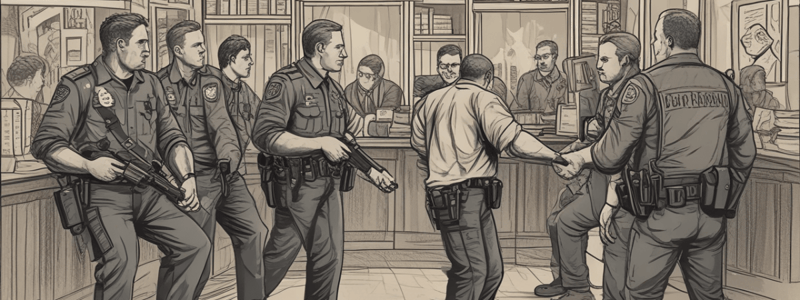Podcast
Questions and Answers
What is the primary responsibility of a sworn member when encountering a situation involving an unarmed subject in crisis?
What is the primary responsibility of a sworn member when encountering a situation involving an unarmed subject in crisis?
- To request a Patrol Division Sergeant
- To protect life (correct)
- To evaluate the totality of the circumstances
- To contain and isolate the threat
Why should sworn members avoid using verbally abusive language?
Why should sworn members avoid using verbally abusive language?
- To establish a rapport with the subject
- To provoke the subject
- To de-escalate the situation
- To avoid escalating the situation (correct)
What should sworn members consider when making a determination about the situation and the need for intervention?
What should sworn members consider when making a determination about the situation and the need for intervention?
- The totality of the circumstances (correct)
- The subject's mental health
- The availability of resources
- The severity of the crime
What is the recommended course of action when facing a unique and difficult situation?
What is the recommended course of action when facing a unique and difficult situation?
What is the potential consequence of using less-lethal devices?
What is the potential consequence of using less-lethal devices?
What should sworn members do when encountering a situation involving an armed subject?
What should sworn members do when encountering a situation involving an armed subject?
How should sworn members communicate with the dispatcher when encountering a crisis situation?
How should sworn members communicate with the dispatcher when encountering a crisis situation?
What is the purpose of requesting additional sworn members to the scene?
What is the purpose of requesting additional sworn members to the scene?
What is the primary responsibility of Tactical Response Teams (TRT)?
What is the primary responsibility of Tactical Response Teams (TRT)?
What is the primary goal of de-escalation techniques?
What is the primary goal of de-escalation techniques?
Which of the following is an example of a de-escalation tactic?
Which of the following is an example of a de-escalation tactic?
When should aggressive action be avoided by sworn members?
When should aggressive action be avoided by sworn members?
What is the primary objective of a negotiator response?
What is the primary objective of a negotiator response?
What is the main priority in a crisis situation?
What is the main priority in a crisis situation?
In which situation would a negotiator response be activated?
In which situation would a negotiator response be activated?
What should a sergeant consider when deciding to initiate an Operation 100 or a Negotiator Response?
What should a sergeant consider when deciding to initiate an Operation 100 or a Negotiator Response?
What is the primary criterion for delaying custody in a crisis situation?
What is the primary criterion for delaying custody in a crisis situation?
What should sworn members do if a subject is threatening to harm themselves and others?
What should sworn members do if a subject is threatening to harm themselves and others?
What is Operation 100?
What is Operation 100?
What is the goal of an Operation 100?
What is the goal of an Operation 100?
Which of the following is NOT a characteristic of Operation 100?
Which of the following is NOT a characteristic of Operation 100?
What should sworn members recognize in a crisis situation?
What should sworn members recognize in a crisis situation?
What should sworn members do if a subject is armed, in their own residence, and is only threatening to harm themselves?
What should sworn members do if a subject is armed, in their own residence, and is only threatening to harm themselves?
Why would a sworn member disengage from a crisis situation?
Why would a sworn member disengage from a crisis situation?
Flashcards are hidden until you start studying
Study Notes
De-escalation Techniques
- De-escalation involves stabilizing a situation to give sworn members time to re-evaluate and assemble proper resources to promote thoughtful resolutions.
- Tactics may include: identifying deliberate attempts to resist, verbal persuasion, warnings, tactical techniques, slowing down the pace of an incident, waiting out a subject, creating distance, and requesting additional resources.
Delaying Custody
- Delaying custody can be used if taking the subject into custody immediately may result in an undue safety risk.
Disengagement
- Disengagement involves intentionally discontinuing contact with a subject in crisis after initial attempts were unsuccessful.
Negotiator Response
- Negotiator Response involves incidents with a single person in crisis who has the intent and proximity to harm themselves and/or others.
- This response requires trained negotiators and one tactical squad for containment and control.
Operation 100
- Operation 100 involves incidents with a sniper, armed or potentially armed suspect, fortified or not, with or without hostages, who has demonstrated the means/intent to cause death or serious injury.
- Sworn members should avoid taunting, insulting, or harassing language that may provoke the subject or escalate the situation.
Procedures
- The initial responsibility of a sworn member is to protect life in situations involving an unarmed subject in crisis, an armed subject, an armed barricaded subject, an armed suicidal subject, or a hostage situation.
- Sworn members should evaluate the totality of the circumstances when making a determination about the situation and the need for intervention.
- Procedures include: notifying the dispatcher, requesting a Patrol Division Sergeant, requesting additional sworn members, and attempting to contain and isolate the threat.
Guidelines
- The primary responsibility of the Tactical Response Teams (TRT) is to train for and respond to Operation 100’s.
- Tactical Pause or Re-Positioning is a tactically superior police procedure that does not signify weakness or cowardice.
- Time is of no importance when handling a subject in crisis call, and aggressive action should be avoided unless there is an immediate threat to life or physical danger.
- Apprehension of subjects, protection of the crime scene, and recovery of property are all secondary to the protection of life.
Studying That Suits You
Use AI to generate personalized quizzes and flashcards to suit your learning preferences.




